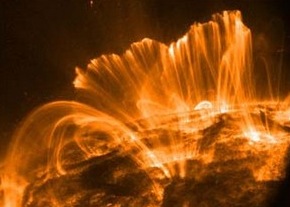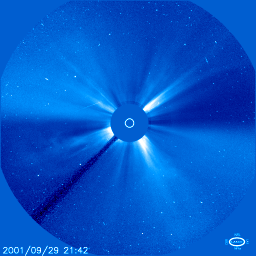Could another Carrington Event destroy our economy?
by Sam Montana, Staff Writer

Could another Carrington Event destroy the economy or worse, destroy civilization, as we know it today. The Carrington Event was nothing more than a solar flare that hit the Earth in 1859. It just happened to be the strongest solar flare to possibly ever hit the planet and the strongest seen and recorded.
On the morning of September 1, 1859, Englandís foremost solar
astronomer, Richard Carrington observed on the sun a large area of
sunspots when suddenly there was a large flash over the sunspots. Within
60 seconds the flash had already started to dissipate. Early the next
morning, reports of the northern lights (Aurora Borealis) were reported
to be so bright that people could read the newspaper as if it were
daylight. The brilliant auroras were reported much further south than
usual in places like Cuba, the Bahamas, Hawaii and El Salvador in
Central America.
The northern lights were unusual enough but then worldwide telegraph
systems started going out. Telegraph operators were being shocked
unconscious and the flying sparks from the telegraph machines were
setting the papers and their machines on fire. When the telegraph
operators disconnected their machines from the batteries, there were
still sparks flying. This is because the power of solar flares induced
electricity into the lines that carried the telegraph signals from one
telegraph station to the next.
Since that time astronomers have been studying the sun and its solar
flares, and have classified them as to their strength of magnitude much
like we do hurricanes. We have satellites that constantly monitor the
sun for any signs of the next big flare and scientists issue solar
forecast and storm warnings. Solar flares are classified by brightness
at their X-ray wavelengths.
X-class is the largest flare.
M-class is a medium sized solar flare.
C-class is the smallest of the flares.
Numbers are attached which are logarithmic, powers of 10. A class X-4
flare is more than 10 times more energetic than a class X-3 flare would
be.

Time lapse of a class M-9 solar flare.
More recent large flares and their effects were,
March 13, 1989, disrupted power in Quebec blacking out 6 million people
for 9 hours. Like the Carrington Event, this also induced current into
the lines, causing power surges that melted a transformer in New Jersey.
There were also 200 other incidents reported on the North American power
grid including a nuclear power plant in New Jersey.
May 1998, a solar flare disabled the PanAmSatís Galaxy IV satellite and
disrupted ATM machines, credit card machines, weather tracking services
and 80% of all pagers in the United States.
November 4, 2003, the largest solar flare ever measured occurred. The
x-rays from this storm were so powerful that it overloaded the
Geostationary Operational Environmental Satellite (GOES) that was
measuring the sun, so scientists had to use other means to measure the
flare. They rated it at X-28.
Before this flare, the strongest ever measured were X-20 flares on April
2, 2001 and August 16, 1989. Had these flares been pointing at the
Earth, the damage to the satellites and power systems could have been
substantial. If the flare isnít pointing at Earth, then most of the
energy goes by the Earth, which is a good thing for us.
What could happen today if another solar flare the size of the 1859
Carrington Event were to hit the planet? According to a report by the
National Academy of Science (NAS) it could induce electrical currents
that would knock out at least 300 main transformers cutting off power to
130 million people, all within 90 seconds.
Solar storms also cause the upper atmosphere to expand or swell which
causes the orbiting satellites to drag in the expanded atmosphere. This
can pull a satellite out of its orbit, fail or actually cause satellites
to burn up in the atmosphere.
The power grids of the United States and other countries are like large
antennas, picking up stray signals. Most of these signals do not cause
any harm since they are small and taken to ground or dealt with
properly. When a large solar flare occurs the geomagnetic currents hit
the earth and the power lines pick them up. This is called
geomagnetically induced currents (GIC). A major solar storm can
overwhelm the system. The solar storm of 1989 that blacked out Quebec
took only 90 seconds from the initial event to a complete blackout. This
causes a cascading affect that if severe enough can cascade beyond the
affecting power company. Our power grid is so interconnected today, that
a failure in one area can cascade to numerous other areas quickly.
A current report by the NAS warns that if a similar event occurred
today, it could cause $1 to $2 trillion dollars in damage to the power
systems and technological infrastructure and take between four to ten
years for a complete recovery. Some areas could be without power for
years. Its not just the lights, but electricity controls everything from
the water supply, phone service, banking and finance, internet and fuel
pipelines to name a few. According to the NAS report, the damage to the
US economy in the first year alone would be at least $2 trillion.
The main agency for watching the sun is the National Oceanic and
Atmospheric Administrations (NOAA) Space Environment Center (SEC). The
SEC warns of impending solar storms so power, cell phone and satellite
companies can take precautions.
NASA has a fleet of spacecraft watching and monitoring the sun,
constantly sending data to Earth. If another major solar flare occurs
and it is pointing at our planet, then the power companies and everyone
else who might be affected can take appropriate action. Much like
heeding a tornado warning. The big question remains, will the warnings
matter if there isnít a lot that can be done to protect the fragile
power grids.
Seems like there is always some danger lurking, but this isnít a brand
new danger as power companies have known about this danger since the
telegraph days. Now that our economy and our daily lives are so
dependant on technology, computer chips and electricity, the concern is
for real.
At this time the sun is in an unusually long quiet period, if the sun
acts as expected, the activity should be picking up again the next
couple of years as we reach another peak in the 11-year solar cycle.
Warning: Never look at the sun with binoculars, camera or a telescope
without proper store bought sun filters, or you will damage your eyes.
© 2009 Sam Montana
Sources and solar web sites
National Academy of Science report
Current solar weather and solar forecasts
Mt. Wilson solar observatory
Copyright © 2008 - 2010 Factoidz.com. All rights reserved. To subscribe or visit go to: http://factoidz.com
(EDITOR'S COMMENT: This is why serious actions should now be happening to strengthen the INDIVIDUAL and his production of electricity. Reliance on the GRID (especially "SMART-GRID") is building dependence on a structure that WILL FAIL! It is just a matter of time.)